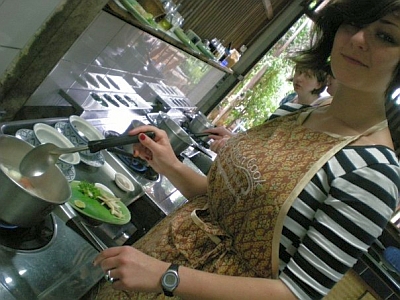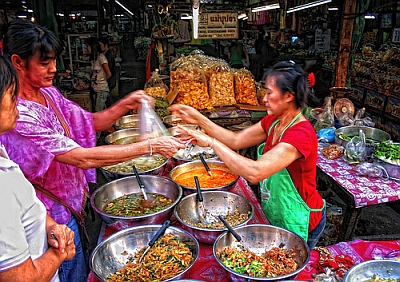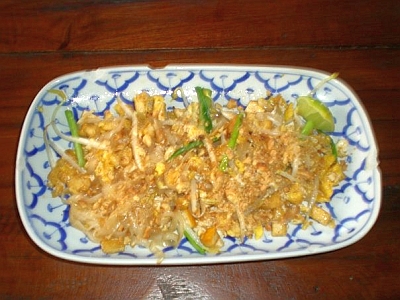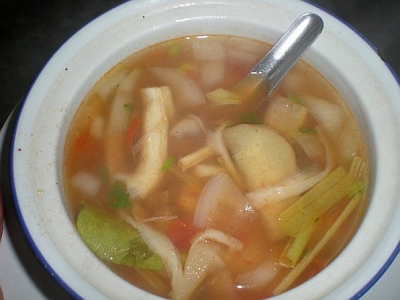The post 6 Ways To Volunteer Abroad From Home appeared first on The Expeditioner Travel Site.
]]>
Orphaned children in Africa, equality for women in India, sex-trafficking in Thailand; these are just some of the issues people wish they could get involved in helping to address. Unfortunately, not everyone has the ability to take off of work and fly to another country to volunteer. This, however, does not mean that the opportunity does not exist for everyone to volunteer abroad.
Many nonprofit organizations now offer opportunities for people living all over the world to volunteer online and in their hometowns to help causes in other countries. These volunteers have the ability to make just as strong a contribution as someone working directly in the field. Moreover, these online opportunities give volunteers a chance to gain a deeper understanding of international issues as well as foreign cultures, just as they would if they were in the country itself.
Here are six ways you can volunteer to help from your own home.
 1) Aid The Nations, Uganda
1) Aid The Nations, Uganda
Aid the Nations is a nonprofit organization that is dedicated to supplying orphans and former child soldiers in Uganda with the hope and resources for a strong and positive future. A 23-year-long gruesome civil war has left the area devastated, and Aid the Nations works hard to repair and rebuild the nation.
One way that you can become involved with this organization from home is to become an ambassador or online intern. By doing this you become directly involved in projects and also have the opportunity to lead them. If you have a special area of interest — for example, marketing, grant writing, social media or video creation — Aid the Nations will tailor projects and tasks so that you can help out while gaining skills in your field.
Aid the Nations also puts a large emphasis on creating awareness as well as on fundraising. On their website they provide educational materials such as malaria brochures for volunteers to use to spread the word of the situation in Uganda. Moreover, they suggest fundraising through carwashes, sporting competitions, bake sales, benefit dinners and concerts. And don’t worry if you have never planned an event — Aid the Nations will help you out to ensure success.
For more information on volunteering online with Aid the Nations, visit AidTheNations.org and click on the “Get Involved” tab.
2) DAAN Foundation, India
DAAN stands for Development Action Awareness Nationwide, and the nonprofit’s mission is “to promote right education and overall capacity building of rural youth and women. To develop their understanding of issues related to health, education, gender-equality, and socio-economic development through awareness generation and capacity building initiatives.”
The major areas of focus include microfinance, microenterprise and livelihoods, human rights, environment, sustainable agriculture, women empowerment, education, health and organizational development.
When becoming an online volunteer, DAAN helps to match the tasks and projects you will be involved in to the skills and interests you hold. For example, if you are a communication buff, some duties could include writing for the organization’s blog, performing online research or helping with online marketing and outreach.
Other possibilities include providing volunteers with mentoring or technical assistance, writing grants and sponsorship proposals, strategic and operational planning, feature and article writing, and even working with budgets.
For more information on becoming an online volunteer for DAAN, visit DaanFoundation.org/online-volunteering.html.
 3) ADRA, Global
3) ADRA, Global
ADRA (Adventist Development and Relief Agency International) works in many different developing areas. Their mission, put simply, is to improve the lives of men, women and children by working to eliminate deprivation, social injustice and needs around the world. Some particular ways that ADRA fulfills their mission is promoting health, supporting families, establishing livelihoods and providing resources.
ADRA offers many opportunities to volunteer online or from home. One way is to take a look at their “Do Something Kit,” which you can download here. When looking through the Do Something Kit, you will find background information on issues affecting people around the world and how ADRA is working to address them. Along with information comes ideas on how you can help, such as fundraising activities and writing to government officials. Everything you need to plan any fundraising efforts is completely laid out for you.
Another way to volunteer is to hold an event and invite a speaker to come talk, or have them speak at an existing event, such as a church service or convention. ADRA can provide the speaker for you, and once you let them know the audience, necessary language, region and topic you want discussed, they will help to pair you with the best speaker for your event needs. You can request a speaker using the form on this page.
For more information on getting involved with ADRA, visit their website at Adra.org.
4) RAIN For The Sahel And Sahara, West Africa
The mission of this nonprofit is to improve the lives of the people in West Africa through education, income-producing activities, agriculture and water security. For those people who live in New England, this nonprofit is based in New Hampshire. A Meetup.com group for the organization meets about once a month in social settings in various towns in New Hampshire to brainstorm fun activities to help raise money for RAIN’s “Girls Scholarship and Mentoring Program,” which helps girls in Niger gain educational resources.
If you are not from the New Hampshire area, there are still ways to get involved with RAIN’s mission. RAIN is looking for people from different cities and states to start Meetup groups in their own areas that can mirror what the New Hampshire group does. You can start one up at Meetup.com.
Furthermore, RAIN has their projects listed on multiple giving sites such as GlobalGiving, Nat Geo Action Atlas and Jolkona, to name a few. Because these are internet-based initiatives, getting the word out about them is vital to the success of the organization’s mission, so those interested in social media, marketing and communication could use their skills in this area. Moreover, most of these websites have options to start a fundraiser and get others on board. Event planners, those with public relations skills and creative types could really play a big part in helping create successful fundraisers for RAIN.
For more information on online volunteering with RAIN for the Sahel and Sahara visit Rain4Sahara.org.
5) CARE, Global
CARE is a leading human rights organization whose mission is to fight poverty worldwide. Their main focus is helping poor women because, when given the proper resources, CARE believes women have the ability to help entire communities. Some of their efforts include preventing the spread of disease, expanding economic opportunities, improving education and protecting natural resources.
There are myriad of ways that online and home-based volunteers can get involved with CARE. Before doing anything, it is best to create a profile on their website, as this can help you interact with other volunteers for feedback and collaboration, as well as for getting information out. You can do that here.
CARE gives volunteers various ways to help spread the word and get their message out. Some of these include writing on their blog, talking to legislators, sending e-cards, utilizing social media and joining their action network, which allows volunteers to take immediate action online. Click here for more information.
Another way to get involved with CARE is to hold or attend a local event. On their website they have a database where you can search events as well as add events. Some event themes include bike rides, fundraisers and conferences. CARE will even help you plan and host the events. For more information on CARE events, click here.
CARE also has a section on their website that encourages volunteers to get involved with CARE’s mission in their community. By visiting this page, you can click on your home state to find our how you can help. Through community projects and programs, you can help end global poverty right from your hometown.
For more information on how to get involved with CARE, visit their website at Care.org.
6) United Nations Volunteers Online, Global
This is a U.N. database of various organizations and projects from a myriad of countries that need online volunteers. Volunteers contribute the skills they have online in order to help organizations address challenges in development while organizations collaborate with the online volunteers to strengthen the impact of their volunteer efforts.
Through their website, you can narrow your search for the online volunteer experience that you want by choosing particular regions, tasks, development topics and hours per week you would like to volunteer. For example, you could search “consulting” and “governance and human rights” in “Eastern Europe” for “6-10 hours per week.”
Visit Onlinevolunteering.org/en/vol/ to search the database and start getting involved in a project.

About the Author
 Jessica, a New York native, is a world traveler who is always looking for a new adventure. She stays active through dance, hiking and cycling, and loves nothing more than her backpack. Follow her travels around the world and the Big Apple on her blog at Jessieonajourney.com.
Jessica, a New York native, is a world traveler who is always looking for a new adventure. She stays active through dance, hiking and cycling, and loves nothing more than her backpack. Follow her travels around the world and the Big Apple on her blog at Jessieonajourney.com.
The post 6 Ways To Volunteer Abroad From Home appeared first on The Expeditioner Travel Site.
]]>The post Cooking Class In Thailand: Learning Culture Through The Tongue appeared first on The Expeditioner Travel Site.
]]>
“Tan Khao Ma Rue Yung?” asks our cooking instructor, as she holds up ginger root, also known as khing in Thai, its sharp and slightly tangy scent awakening my sense of smell.
We are standing in a Chiang Mai market choosing fresh ingredients for the day, and she has just asked us if we have eaten yet. Even if I had, the different aromas of fresh vegetables and salty meats mix with pungent spices, making my stomach growl. The smell of fish, just caught this morning, is usually enough to make me lose my appetite, but not today. My friend Jenny and I have decided to take a Thai cooking class to learn more about Thai culture through food. We have chosen the instruction company Smart Cook and are both extremely excited, and hungry, for the day.
Our instructor, a thin Thai woman with a big smile and loud voice, leads us to another stall and picks up something that appears to be a cross between a yellow tree branch and a giant french fry.
“This is turmeric root,” she explains. “It will not only make your dishes delicious, but also helps aid digestion, relieves arthritis, and gives you energy. Many of the herbs and spices in Thai dishes make these meals very healthy.”
 We continue to walk around the market, taking in the unfamiliar sights, sounds and smells, as we are used to buying our produce from big name supermarkets. Of course, the foods Jenny and I usually consume at home undoubtedly contain pesticides, growth hormones and various other toxins. Everything here is freshly grown and free range.
We continue to walk around the market, taking in the unfamiliar sights, sounds and smells, as we are used to buying our produce from big name supermarkets. Of course, the foods Jenny and I usually consume at home undoubtedly contain pesticides, growth hormones and various other toxins. Everything here is freshly grown and free range.
Our shopping list includes a variety of items: Shrimp paste, a mixture with a strong, salty redolence derived from dried shrimp; Thai garlic, which is sweeter than the Western variety; juicy papaya; protein-rich chicken; and tiny green chilies, the spiciest kind, are all part of our purchase. When we are finished and it is time to go over to the cooking school, I am confident we have visited every stall in the market at least once.
Our classroom is outdoors, which I find to be refreshing and energizing as it is a sunny day in Chiang Mai. After each dish, we will be lead to a dining room where tables are set up with cushions to kneel on while we enjoy the food we have prepared.
The first dish of the day is Phat Thai. We put on our aprons and are handed knives. We cut up onion and mix it with bean sprouts. Chopping garlic must also be done, which proves to be quite fun as we must first peel it and use the flat blade of our knives to smash it open by pressing the knife with the palm of our hands. Moving over to the stove area, we find giant woks set up for our cooking pleasure.
As I begin by frying bits of tofu and adding a the garlic that I had chopped myself, I picture my dad cooking at our home in New York. He always seemed to know exactly which spices to add to a meal to liven it up, or which herbs would pair best with what ingredients. I knew he would be proud of me at this moment.
 Once all of the ingredients have been added to the wok and thoroughly cooked, I pour the contents onto a plate, adding chili powder, peanuts, and lime juice to enhance the flavor. Looking down at my masterpiece, I pull out my camera and take a picture.
Once all of the ingredients have been added to the wok and thoroughly cooked, I pour the contents onto a plate, adding chili powder, peanuts, and lime juice to enhance the flavor. Looking down at my masterpiece, I pull out my camera and take a picture.
Jenny and I head over to the dining area and begin eating. The Phat Thai is so delicious that I cannot believe that I actually cooked this myself. Our instructor tells us a bit about traditional communal eating in Thailand.
“Every dish of food is shared from a common plate which have their own serving spoons,” she explains. “All kinds of vegetables and meats are laid out. Normally, people place these foods on their own individual bowl of rice. Thai people eat like this to form a sense of closeness by serving each other and discussing the flavors of each dish.”
For our next course we make green curry with rice. Being a big fan of curry, I am excited to have the authentic kind. For this dish, we make a paste by pounding together different ingredients in a mortar. Peppercorns to infuse the intensity and flavors of the meal, coriander seeds, which aid digestion as well as migraines, and cumin seeds, with their nutty and peppery flavor are mashed together. A myriad other herbs and spices are blended and mixed in, including tiny green chilies.
“Many people believe that red chilies are the hottest,” explains our instructor. “The truth is that the tiny green chilies are the spiciest.”
We add shrimp paste and pound the mixture, then add it to rice. And, as we kneel down to eat our works of art, the spicy scent of green curry enticing my nostrils and making my stomach growl, I forget that only 25 minutes ago I had eaten a dish of Phat Thai.
The first bite is seductively hot, burning my mouth and causing my body to tingle a bit, while still beckoning me to eat more. It is addicting, and I can’t seem to stop spooning the delicious concoction into my mouth, until suddenly, something isn’t right.
“Oh no,” I whisper hoarsely to Jenny, the burn singeing my vocal cords. “I think I just swallowed a tiny green chili.”
The instructor looks at me with wide eyes. “Let me grab you more water and some sticky rice,” she says, jumping up to grab a pitcher.
The chillies are just added to flavor the dish but are really not meant to be swallowed themselves. I learn this the hard way.
My eyes fill with tears and as soon as the pitcher of water is set in front of me I begin chugging. As I continue to gulp down the liquid, swishing it around in my mouth hoping to extinguish the flame the tiny green chili has ignited, I learn another lesson in Thai culture: They can really handle spice!
My mouth begins to feel only somewhat like a fire had erupted in it when we begin to prepare the next meal: Tom Yam Kung, which is a hot and sour soup with prawns. For this dish we once again prepare our ingredients before we cook. We slice up lemon grass, the sweet citrusy smelling plant that acts as an anti-inflammatory as well as all-natural acne medication, kaffir lime leaves, which will blend with the lemon grass to give the soup an essence of lemon, and straw mushrooms, a mild flavored vegetable that can help lower cholesterol as well as treat cancer. After adding the remainder of the ingredients, adding them to large pot to boil, and then seasoning, we are set to eat.
“‘Tom'” means boiled,” our instructor tells us, “so we must serve this while it is still boiling.”
 We learn that what makes Thai cuisine so special is not only its health benefits, but also the combination of tastes it incorporates, such as sweet, salty, sour, spicy, and bitter. After one bite of the Tom Yam Kung, I can tell why this is such a popular dish. Due to the array of herbs and spices blended together in the soup, every taste is present.
We learn that what makes Thai cuisine so special is not only its health benefits, but also the combination of tastes it incorporates, such as sweet, salty, sour, spicy, and bitter. After one bite of the Tom Yam Kung, I can tell why this is such a popular dish. Due to the array of herbs and spices blended together in the soup, every taste is present.
Since my mouth is now fully recovered, I welcome the hint of heat from the chili, the salty flavor from the fish sauce, the sweet taste of sugar, and the sour addition of the lemon. A literal melting pot is happening in my mouth at that very moment, and I am happy to be the host.
For our last dish, we create something cold and refreshing, Som Tam, which is a papaya salad. Although this dish is technically a salad, I was reminded that we are in Thailand, and to expect flavors of sweet, sour, salty and spicy to be present in the meal.
First, Jenny and I pound garlic, a natural antibiotic with a spicy tang, and chili in a mortar followed by Chinese long bean, a chewy and hearty vegetable containing many antioxidants and heart-healthy benefits. Other ingredients, such as palm sugar, fish sauce, and lime juice, are added, and the salad is topped with papaya. I also toss in some peanuts, which is a common addition to Som Tam.
Jenny and I kneel down at the dining table for our last time. Back home, I would not have thought to combine spice with fruit, but in this dish it seems to work. While I find it odd to end the course with a salad, I love the fact that there are no rules here as to when something should be eaten. At one moment I begin to sweat from the chili, while the next I am revitalized by the papaya. It is both confusing and welcomed.
We finish our meal and get up to wai, a common bow-type gesture, the instructor. Not only has she helped me enjoy delicious Thai cuisine while helping me realize my own cooking abilities, she has taught me a lot about the culture of Thailand through cuisine, and for this I am forever grateful.

If you travel to the Chiang Mai, Thailand, area and would like to take a cooking class with Smart Cook, you can contact them directly at +66 (0) 8 6186 3468 or at smartcookthailand@yahoo.com.
About the Author
 Jessica, a New York native, is a world traveler who is always looking for a new adventure. She stays active through dance, hiking and cycling, and loves nothing more than her backpack. Follow her travels around the world and the Big Apple on her blog at Jessieonajourney.com.
Jessica, a New York native, is a world traveler who is always looking for a new adventure. She stays active through dance, hiking and cycling, and loves nothing more than her backpack. Follow her travels around the world and the Big Apple on her blog at Jessieonajourney.com.
The post Cooking Class In Thailand: Learning Culture Through The Tongue appeared first on The Expeditioner Travel Site.
]]>